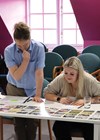Audiology features
Lenire as a clinical tool for treatment of tinnitus
Lenire offers a promising but varied solution for tinnitus relief. Peter Byrom shares insights on its effectiveness, challenges and patient outcomes. I have been involved in tinnitus support for at least 20 years, including a stint on the then British...
Lights, camera, hearing: cinema as a catalyst for cochlear implant awareness
Cinema is reshaping how we see cochlear implants – raising awareness, sparking conversation and showing the power of representation. Cinema wields immense power in shaping societal perceptions and sparking dialogue around medical and social issues. In the realm of hearing...
Minimum stimulus strategy for the diagnosis of BPPV
Explore the innovative minimum stimulus strategy (MSS) for diagnosing benign paroxysmal positional vertigo (BPPV), enhancing accuracy while minimising patient discomfort. Benign paroxysmal positional vertigo (BPPV) is a common vestibular disorder where canalolithiasis or cupulolithiasis causes sudden episodes of vertigo, triggered...
Where ART meets Science: The Silence You Can Hear
Some moments have a sound you don’t hear with your ears but feel with your entire being. The artwork DS21008 (200 cm x 120 cm) captures such a moment: a Sunday morning in Maastricht, where the river Maas reflects the...
Ida Institute’s legacy and the future of person-centred care
Professor Kris English reflects on the IDA Institute’s closure, celebrating its legacy of advancing patient-centred care and reshaping audiological counselling worldwide. In September 2008, the Ida Institute’s Director, Lise Lotte Bundesen, and her team held its inaugural ‘Defining Hearing Seminar’...
Rethinking tinnitus ‘care’: the role of digital solutions
Experiencing tinnitus can be very distressing and accessible care is limited. Digital therapeutics is one way of addressing these concerns, as described by Dr Bardy. Tinnitus presents a significant clinical challenge for various healthcare professionals, including general practitioners (GPs), ENTs...
How to identify and support adults with auditory processing disorder: a focus on low-gain devices and auditory training
Some adults struggle with hearing in noise despite normal audiograms. Tools like the HHIA, low-gain devices and auditory training can help identify and support these cases. In this article, Angela Alexander and Fatima Abbas use a case study to discuss...
Tish Gaffney – AAA President
From a sunny Southend, UK, Gareth Smith takes 10 minutes to dial into the Sunshine State, USA, and catch up with Tish Gaffney for a lightning-speed chat on the movements and motivations of the 35th president of the American Academy...
Protheses for patients with severe bilateral vestibular loss
In February 2003, I met a patient with severe bilateral vestibular loss due to gentamicin toxicity, and I felt disheartened. Despite the fantastic diagnostic vestibular lab we had at Maastricht University Hospital, what could I truly offer her? She had...
Where ART meets Science: A unifying story in ENT & Audiology News
We are delighted to introduce a stunning new cover series by Dyon Scheijen, a Maastricht-based clinical physicist-audiologist and artist fascinated by the psychology of hearing. Dyon explores the connection between audiology, acceptance and commitment therapy (ACT) and sound perception. He...
The ups and downs of overseas research – the inner ear at altitude
Conducting research at extreme altitude presents unique challenges. This study of the inner ear at 5350m navigates setbacks in a quest for scientific discovery. Having completed a diploma in mountain medicine in my foundation years, I decided to undertake a...
Empathic consulting: elevating audiology through connection
A new course in empathic consulting helps audiologists deepen patient trust and engagement, focusing on emotional insight to improve care quality and consultation outcomes. Leightons and The Hearing Care Partnership have developed an innovative course focused on empathic consulting for...

















